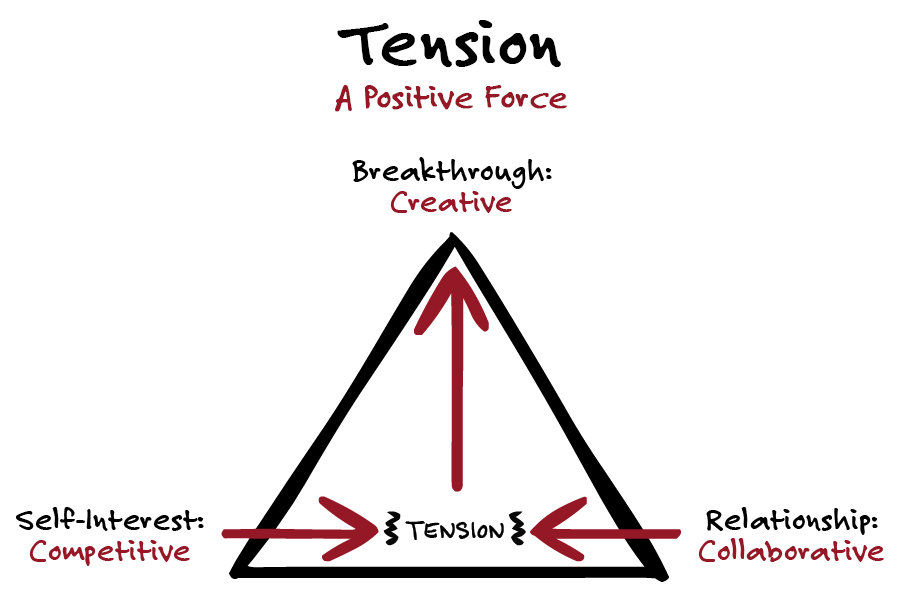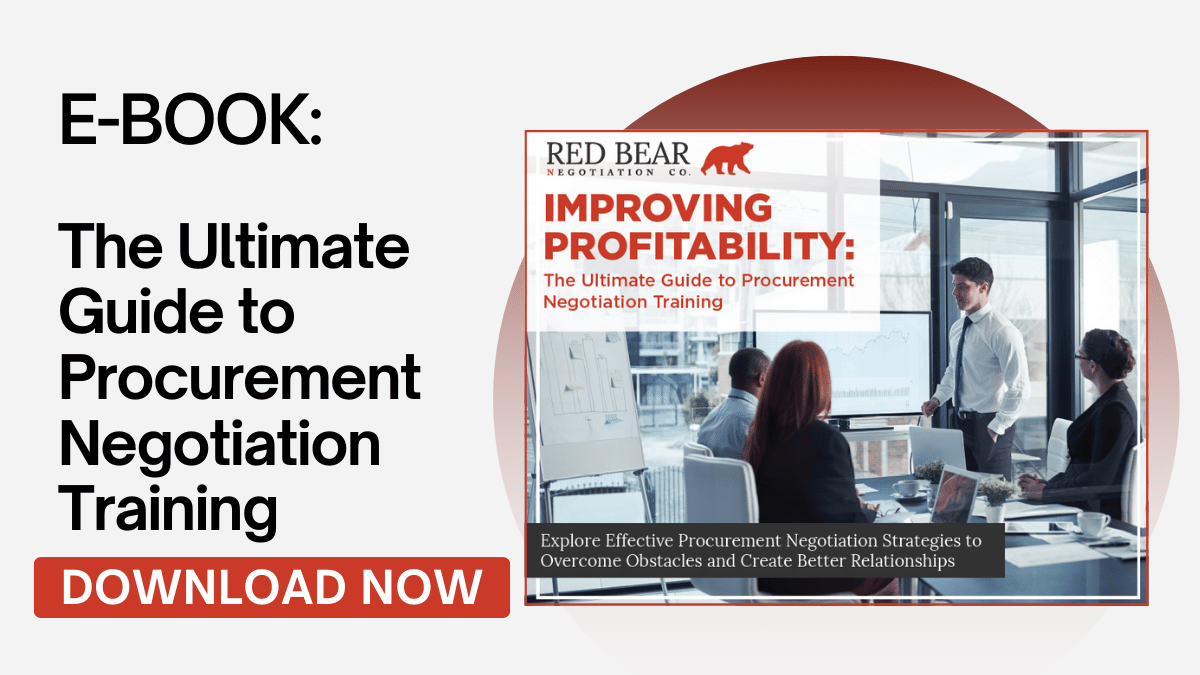Past, Present, and Future of Negotiation for Procurement
Purchasing and Supply Chain Negotiation Skills
Procurement Negotiation Strategies
- Negotiation Behaviors: Interests and Positions
- The Procurement Negotiation Model
- The Value of Standardizing the Negotiation Process
Procurement Negotiation Training for Every Scenario
- Negotiation Training for Every Role
- Mastering Vendor Negotiations
- Effective Approaches to Supplier Negotiations
- Notes on Virtual Procurement Negotiation
- Building a Negotiation RFP
Procurement Training: Sustain Learning
- Coaching and Reinforcement Workshops for Procurement
- Virtual Toolbox and Virtual Instructor-Led Training
- Cross-Cultural Negotiation
- 100minutes to Improved Supplier Negotiation
- Measurement
Negotiation Training From Procurement Experts: Partner With RED BEAR
Improving Profitability: The Ultimate Guide to Procurement Negotiation Training
Procurement isn’t just about purchasing products or services; it’s about building partnerships, managing costs, and steering the company toward profitability and growth.
It’s the art and science of negotiating the best possible terms, ensuring that both your organization and your suppliers thrive together. This is where the value of effective negotiation training comes into play — and the right procurement negotiation training program can make all the difference.
Training can help your team build better relationships, manage expenses without compromising quality, and push individuals to excel in external and internal negotiations for cohesive team outcomes.
Consider this your guide to the world of procurement negotiation.
We’ll walk you through the nuances, challenges, and strategies that can transform your purchasing team into negotiation maestros.
That’s the power of RED BEAR Negotiation Training.
Our mission isn’t to teach manipulative tactics or one-off strategies like other negotiation training companies. Instead, we focus on the principles and behaviors that drive successful negotiations.
“Our mission isn’t to teach manipulative tactics or one-off strategies like other negotiation training companies. Instead, we focus on the principles and behaviors that drive successful negotiations.”
That’s why our tested methods are used by 45% of the Fortune 500 and return $54 for every dollar invested in our training.
Whether your team is new to procurement or seasoned professionals looking to refine their skills, this guide will offer you insights that can elevate your negotiation strategies to the next level.
Past, Present, and Future of Negotiation for Procurement
As businesses stride forward in an ever-changing marketplace, understanding the trajectory of procurement negotiations is paramount.
The challenges of the last few years have fundamentally changed procurement practices. This change emphasizes the indispensable need for adaptive and forward-thinking approaches to negotiation.
Let’s explore these changes together.
Statistics and Trends
Nothing beats data. When you have the numbers in hand, you can paint a clear picture of the environment every procurement specialist has dealt with over these last few tumultuous years.
First, of course, is the thorny issue on every business's mind: inflation.
Inflation has cast its shadow far and wide, affecting organizations across all sectors. It's not just impacting supplier costs and the price of raw materials but also impacting everything from freight charges to wage bills.
By some estimates, inflation has seen cumulative rise in the U.S. of around 17% from 2020 to 2023.
Alongside inflation is the pain of supply chain issues. While some disruptions from the COVID-era may have waned, supply chain challenges persist.
Around 71% of surveyed global manufacturing companies argue that raw material costs are still a challenge in 2023. The trick to conquering this formidable issue? Negotiation skills training.
When you can build better relationships with suppliers through effective negotiation, you can weather the storm of supply chain disruptions and set better terms for delivery flexibility and pricing.
Adding to the challenges of building resilient supply chains are risks from geopolitical instability.
6 out of 10 global organizations expect that geopolitical instability may have a detrimental impact on their supply chains in the next three years.
These supply chains are often quite complex, too.
For example, in the aerospace industry, the average business might work with upward of 12,000 suppliers.
When your team can master negotiations with the right training course on procurement, they can build better, more resilient supply chains. Resilient supply chains are more than just a buzzword; they’re a critical business imperative, especially in today's uncertain economic landscape.
A supply chain that can quickly adapt and recover from disruptions — whether they’re caused by international events like pandemics and geopolitical tensions or industry-specific challenges like raw material shortages — ensures uninterrupted business operations.
Here's how resilience translates to profitability:
- Reduced downtime
- Mitigation of cost overruns
- Enhanced brand reputation
- Strategic inventory management
- Agile response to market demands
The Onset of the Manufacturing Supercycle
The recent years have undeniably been tough. From the grips of inflation to ongoing supply chain disruptions, businesses face a multitude of challenges.
Yet, emerging data hints at a silver lining. With increased internal investments, especially in the 2020s, the U.S. has seen transformative legislative efforts aiming to bolster the nation's industrial sectors.
Some economic experts suggest that we might be on the verge of a manufacturing supercycle. As investments pour in, coupled with pent-up demand, indicators such as the burgeoning employment in the construction sector — currently at its highest since 2013 — suggest a hopeful horizon.
Negotiation Challenges Procurement Faces Today
These days, the business landscape seems to be changing almost daily. To keep up with these unique challenges, procurement professionals need the right training and tools to succeed.
Here are a few challenges facing procurement specialists:
- Navigating a Hyper-Globalized Market: With over 70% of companies transitioning their manufacturing operations into Asia between 2018 and 2023, procurement professionals face challenges related to logistics, understanding local cultures and regulations, and addressing time zones and communication barriers.
- Capturing Growth in Emerging Markets: The anticipated 4.0% growth in emerging markets in 2023 presents both opportunities and challenges. Key issues include navigating cultural negotiation differences, contending with political and economic instability, and addressing infrastructure inadequacies.
- Doing More with Less: The ripple effects of past supply chain shortages mean procurement professionals must operate with tighter budgets, rebuild consumer trust, and diversify their supplier base. This requires strategic sourcing and negotiation skills tailored to a volatile trade environment.
To navigate these challenges, procurement professionals must blend their negotiation skills with a deep understanding of global trends, cultural nuances, and market dynamics.
Purchasing and Supply Chain Negotiation Skills
If these stats and trends tell us anything, it’s that to navigate the landscape of procurement and supply chain management today, teams need to value one thing that is often overlooked: relationship building.
Establishing and nurturing long-term relationships with suppliers not only provides a buffer against the myriad of challenges previously discussed but also paves the way for securing favorable terms.
It's about more than just transactional gains.
“It's about more than just transactional gains.”
These types of relationships inevitably bolster your company’s financial resilience. This translates to cost savings, increased vendor accountability, and optimized working capital.
In essence, strong supplier relationships are a two-way street, yielding mutual benefits.
Negotiation Principles and Behaviors
Here at RED BEAR, we focus on the principles and behaviors that drive successful negotiations. We believe that with the right foundation, you can accelerate revenue/margin growth, reduce costs, drive greater internal alignment, improve your team’s cross-cultural expertise, and support the achievement of other critical organizational goals.
So, what are the principles and behaviors that stand as the bedrock of our advanced negotiation skills training? Let’s explore these concepts together.
First, we’ll take a look at the principles of successful negotiations:
- Position Your Case Advantageously: Start with a compelling case to set a strong foundation. For example, a procurement professional might present a case for a bulk purchase by highlighting long-term savings and reliability.
- Set High Aspirations: Aim high to provide more room for negotiation and better outcomes. Let’s say a procurement manager aims to secure a 20% discount on an order knowing that, if negotiated down, they can still receive a significant discount.
- Manage Information: Use discretion in sharing and uncovering information for a strategic advantage. A procurement team might withhold certain budget constraints while learning about a supplier’s flexibility in pricing or additional services.
- Understand Your Power: Recognize and leverage your unique strengths. This can be as simple as recognizing a company’s large order volume will entice suppliers and use this power to negotiate favorable terms.
- Prioritize Needs Over Wants: Focus on the essential requirements before addressing desires. Rather than opting for additional features or products, a procurement team might focus on essential suppliers to ensure continuity during peak season.
- Plan Your Concessions: Give up points strategically to build trust and reciprocity. Here, a negotiator might agree to a slightly higher price per unit in exchange for longer payment terms or delivery assurances.
Building strong supplier relationships is crucial for securing favorable terms and enhancing a company's financial health. These principles help your team develop deep insights into how to approach negotiation and better navigate the tension of these types of discussions.
Of course, the principles are only one part of negotiation. There are also the foundational negotiation behaviors:
- Make Demands: Clearly assert your wants and needs.
- Ask Open Questions: Encourage discussions that unearth underlying needs.
- Test and Summarize: Reflect and confirm your understanding of the other party’s position.
- Propose Conditionally: Suggest creative, non-specific ideas for mutual benefit.
- Make Trades: Concede only when ensured of an equal or greater return on value.
It’s worth noting that you’ll find two types of negotiation behaviors: relationship-building and self-interested. These two types leverage different dimensions of a negotiation — which we’ll explore a little later.
But, it gets to an important point. Negotiations are a balance of the competitive, collaborative, and creative dimensions. Using these behaviors and principles effectively can help your team master this balance.
Procurement Negotiation Strategies
A structured negotiation process, like the one you’ll develop through RED BEAR’s negotiation workshops, will ensure consistency and scalable outcomes in your everyday procurement operations.
The right negotiation process will create standards around negotiation that emphasize long-term success and will empower even those without the innate talent to negotiate effectively. With distinct planning phases, such as research and anticipation, and common language around negotiation, it provides a comprehensive readiness for various negotiation contexts.
This process is the antithesis of the manipulative tactics and one-time-use strategies sold by other procurement negotiation training courses.
To highlight the value of RED BEAR training, let’s explore some key concepts in more depth.
Negotiation Behaviors: Interests and Positions
Since we’ve already outlined the negotiation behaviors, we’ll connect them to procurement so you get a sense of the power and value these concepts bring to the table.
Let’s break them down one by one:
- Making Demands: In procurement, clearly stating requirements, such as delivery times, quality standards, or volume discounts, is critical. This ensures suppliers know what’s expected of them and sets a baseline for negotiations.
- Ask Open Questions: This behavior is invaluable for understanding suppliers better. By asking questions like, “What challenges do you foresee with this contract?” or “How can we work together to achieve bulk discounts?”, you can uncover hidden obstacles or opportunities.
- Test and Summarize: It’s vital in procurement to ensure both parties are on the same page. After hearing a supplier’s offer or concerns, summarizing them ensures clarity. For instance, “So, if we commit to a longer-term contract, you can offer better pricing?”
- Propose Conditionally: This is especially important in procurement, where conditions often dictate agreements. For example, “If we can guarantee consistent quarterly orders, would you be willing to offer a 10% discount?”
- Make Trades: Procurement often involves a give-and-take. If a supplier can’t meet a delivery deadline, perhaps they can offer expedited delivery for future orders. Recognizing and capitalizing on these trade opportunities ensures that both parties feel the deal is beneficial.
Understanding these behaviors, and using them, can help build healthy tension in negotiations. In procurement, you can achieve this healthy tension when you balance the competitive and collaborative dimensions of negotiation.
This healthy tension is pivotal in creating innovative solutions that serve the buying organization and the supplier.
For example, while the procurement team might push for the best price (competitive dimension), they also need to make sure the supplier feels valued and sees the potential for a long-term relationship (collaborative dimension).
While behaviors like "Making Trades" might lean toward the organization's self-interest, the majority, such as "Ask Open Questions" or "Test and Summarize," are geared towards building and nurturing relationships.
The Procurement Negotiation Model
Most negotiations are like a Rubik’s cube. For the uninitiated, they can feel challenging, and require a natural wit and intellect to master the puzzle.
Here at RED BEAR, we know that with the basic concepts down, solving the Rubik’s cube of procurement negotiations is not as difficult as it first appears. Sure, it might take some practice, but ultimately, finding the right solution to the puzzle is well within your reach.
The trick is having the right perspective and approach to negotiation.
We’ve already explored the principles and behaviors; now it’s time to unearth the three dimensions of every procurement negotiation.
With these in hand, you’ll be able to easily tackle the procurement discussion puzzle.

Competitive Dimension
First, let’s learn about the competitive dimension. This is often the one most of us imagine when we think about negotiation.
This dimension revolves around self-interest.
You want to grow your company, but not at any cost - you must do so while preserving and protecting your own interests.
As discussions advance, negotiations can turn tactical. This dimension emphasizes aspects like cost, delivery times, and contract specifics. Here, the objective is to secure the best terms for the organization while keeping the deal fair for the supplier.
Stick here too long, and you might end up with a win-lose situation. That’s why your team should understand each dimension and how the three interact.
Collaborative Dimension
Collaboration is the key to finding common ground and reaching win-win outcomes.
You have a requirement to not just maintain - but enhance your relationships, oftentimes in the face of excessive or unrealistic demands.
At the onset of procurement negotiations, there’s often a focus on fostering mutual understanding and building sustainable relationships with suppliers.
This phase emphasizes trust, transparency, discovering new negotiables, and long-term partnership goals.
Creative Dimension
Last is the creative dimension.
Here is where both parties look to break beyond impasses, identify value-for-value exchanges, and create winning scenarios for everyone.
This might involve brainstorming innovative solutions to meet the organization's needs and accommodate supplier constraints.
To find success in negotiation in procurement, you need to not only recognize these dimensions but also seamlessly navigate between them.
“To find success in negotiation in procurement, you need to not only recognize these dimensions but also seamlessly navigate between them.”
Effective negotiators are situational.
That means they always assess the situation to find the right time to be competitive, use a collaborative approach when necessary, and find creative solutions when they reach impasses between parties.
The Value of Standardizing the Negotiation Process
Ensuring clarity, efficiency, and effectiveness in any negotiation situation is paramount.
At the heart of this is creating standards around negotiation planning, eventually building into a negotiation process your team can use in every procurement environment.
Central to this process is a negotiation planner.
Serving as a roadmap for procurement specialists, a planner prepares your team. While inherent talent is always a valuable asset, when you have a systematic planning and training process in place, every team member can negotiate with confidence.
With RED BEAR’s course on procurement negotiation, you get all the tools you need, including a robust negotiation planner built on the principles and behaviors.
But, beyond planning, a universal language for negotiation is essential.
Imagine the inefficiencies in a global enterprise where procurement teams spanning regions and departments grapple with different negotiation terminologies. The lack of a common language not only breeds confusion but also delays the alignment of negotiation strategies.
By embracing a unified negotiation process and vocabulary, teams enter discussions on a shared frequency, dramatically streamlining planning and strategy development.
Let’s take a look at some ways a negotiation planner and planning, in general, will pay off.
Build Influence During Negotiations
Influence in negotiations is critical for every procurement specialist to understand.
When you implement a standardized process around negotiation, you inherently build credibility and influence.
This systematic approach is not just about following a step-by-step procedure but also about understanding the depth and breadth of your bargaining power. Being aware of the full range and strength of your power can help you navigate negotiations more effectively, ensuring you wield influence at critical junctures.
Opening Techniques: What You Need to Know
The beginning of a negotiation lays the foundation for everything that follows.
How you set terms and initial offers can impact the trajectory of the entire negotiation. Planning ahead, then, becomes incredibly important.
When procurement professionals prepare by establishing clear terms and setting a roadmap for the negotiation, they not only exude professionalism but can also steer the conversation in a direction that aligns with their objectives.
The Right Approach to Bargaining
Bargaining doesn't merely revolve around haggling or making demands. It's about strategy.
“Bargaining doesn't merely revolve around haggling or making demands. It's about strategy.”
One essential component of the right approach to bargaining is the development of a concessions strategy. This requires you to understand the concessions you’re willing to make, at what stages of the negotiation, and how these concessions play into both sides reaching a favorable outcome.
When you approach bargaining from a structured perspective rather than an ad-hoc back-and-forth, the negotiation flows smoothly, and the odds of reaching a win-win outcome increase.
Instead of Closing, Focus on Maximizing Outcomes
In procurement, the end goal isn’t only to conclude a deal but to optimize the outcomes for both parties.
With a negotiation process in place, you create an avenue to maximize the value derived from each agreement. This often leads to scenarios where both parties leave the negotiation table feeling satisfied.
When you shift the focus from just closing to maximizing outcomes, negotiations become an opportunity for mutual growth rather than a mere transaction.
“When you shift the focus from just closing to maximizing outcomes, negotiations become an opportunity for mutual growth rather than a mere transaction.”
Procurement Negotiation Training for Every Scenario
Effective procurement negotiation is a game-changer.
When you consider that organizations typically allocate almost 70% of their revenue to non-labor costs, the significance becomes apparent. A mere 1% reduction in these costs can amplify profits by over 4%.
Yet, the classic confrontational approach to vendor negotiations is becoming obsolete in the modern global business framework.
Success now hinges on fostering profitability while nurturing supplier relationships.
Negotiation Training for Every Role
Whether you’re a Purchasing Manager, involved in direct or indirect procurement, or a Chief Procurement Officer (CPO), customized negotiation training is vital.
It ensures that each role understands its unique challenges and opportunities within the procurement landscape. Let’s take a look at each one:
- Purchasing Managers: Often the front-liners in negotiations, they need to grasp product specifics, market dynamics, and vendor motivations. Training can sharpen their deal-making to better align negotiations with organizational objectives.
- Direct Procurement Professionals: Their focus is on raw materials and goods for production. Training equips them to understand material nuances, global market trends, and the art of long-term contract negotiation.
- Indirect Procurement Professionals: Handling diverse non-production goods and services, their training emphasizes cost-efficiency, service quality, and risk management.
- Projects Procurement Management: This group manages and optimizes project’s budgets as they apply to the goods, services, and resources needed to complete the project.
- CPOs: As strategic overseers, their training melds high-level negotiation strategies with leadership skills. Engaging with top-tier suppliers, CPOs negotiate deals that can shape the organization's future.
Mastering Vendor Negotiations
The historical blueprint for vendor negotiations, which promotes a contentious relationship between buyer and supplier, is waning in its effectiveness.
Today, the drive is to view vendors as strategic relationship architects.
How to Negotiate With Vendors
To master negotiations with vendors, here are a few tips to follow:
- Understand that price is only part of the broader discussion. Focus on other areas, such as quality, delivery, responsiveness, inventory management, and other tangible benefits.
- Act as collaborators and work with internal stakeholders to identify suppliers that align with their requirements.
- Partner with a select group of key suppliers to forge long-term collaborations that deliver value far beyond price.
Effective Approaches to Supplier Negotiations
Successful supplier negotiations hinge on more than just securing the lowest price. The real winners in this domain strive for:
- Global logistics and delivery improvements
- Strategic information sharing
- Efficiency enhancement through creative staffing solutions
- Transparent relationships that anticipate supply chain disruptions
How can procurement professionals get here? Let’s take a look at some effective tips.
Tips for Negotiating With Suppliers
When it comes to negotiating with suppliers, RED BEAR’s advanced negotiation skills training offers some concrete steps toward mastering supplier management. Here is what you need to know:
- Strive for more than a lower price
- Manage information strategically
- Identify underlying needs
- Manage concessions
- Plan before negotiations
- Welcome creative tension
If these sound familiar, they should. That’s the value of RED BEAR Procurement Negotiation Training. With the fundamentals that drive successful negotiations down, you can enter any negotiation with confidence — whether it's with suppliers, vendors, or anyone else.
Notes on Virtual Procurement Negotiation
The digital age has amplified the complexity of negotiations. As the landscape of procurement evolves, the demand for virtual negotiations becomes a norm.
The shift to virtual procurement negotiations, however, comes with its own set of challenges and rewards. Let’s explore a real RED BEAR client to put this into perspective.
A leading automation and controls enterprise wanted to reduce supplier costs by embracing global sourcing and expanding to emerging markets. Despite the potential benefits, this strategy was met with internal resistance from business units wary of change.
The company needed to secure favorable economic terms without compromising quality.
With guidance from RED BEAR, the company was able to foster internal collaboration and secure efficient, quality-assured supplier agreements. This endeavor highlights the importance of strategy and adaptability in the face of an evolving virtual procurement landscape.
Building a Negotiation RFP
A well-designed request for proposal (RFP) is essential when scouting for the ideal course on procurement negotiation.
But, crafting an RFP can be its own challenge. To get it right, ask these questions:
- How can the company define and measure its objectives?
- Are their training courses customized?
- What are their global capabilities?
- How does the company measure results?
- How do they deliver their training?
- What kind of documentation do they provide?
- What does post-training support look like?
- What’s your budget and timeline for training?
With these questions in mind, you can craft a precise negotiation RFP that addresses all your negotiation skills training needs.
Procurement Training: Sustained Learning
Procurement negotiation training, at its core, aims to instill an effective, streamlined, and consistently actionable process.
By doing so, it enables negotiators to frame supplier agreements in a manner that fortifies your company’s financial health and aligns with broader business objectives. Ill-conceived supplier negotiations can set your team back not only financially but in terms of missed opportunities to optimize cycle times, manage stock efficiently, enhance product quality, and achieve improved supplier responsiveness.
RED BEAR’s Negotiating With Suppliers (NWS) program offers an in-depth dive into the following:
- Fundamental principles of negotiation
- Negotiation behaviors
- Concessions strategy
- Elegant negotiables
After your team masters the Negotiating With Suppliers program, the journey doesn’t end.
Negotiating With Suppliers 2 (NWS 2) welcomes past participants to delve deeper. Customized for these alumni, NWS 2 offers fresh, potent strategies to address and resolve conflicts within a professional context.
We also offer Negotiating With Suppliers 3 (NWS 3) that goes even further to help your team foster greater collaboration, fuel innovation, and invigorate and master the negotiation process.
Coaching and Reinforcement Workshops for Procurement
The Coaching and Reinforcement Workshop (CRW) equips managers with a structured roadmap to coach their teams in applying new negotiation skills in real-world scenarios. The program achieves three primary objectives:
- Builds motivation
- Empowers through coaching
- Provides practical application of learned skills
Training is not a one-time event.
“Training is not a one-time event.”
The most successful procurement specialists evolve their strategies to meet the demands of market trends, geopolitical pressures, and much more.
The CRW gives these professionals the tools they need to practice and continually improve their skills — while teaching others.
Be sure to connect with the RED BEAR team to learn more about CRW.
Virtual Toolbox and Virtual Instructor-Led Training
RED BEAR believes in honing negotiation skills through hands-on practice in real-world contexts. While traditional training often favored face-to-face interaction, the evolving business landscape has thrust online interactions to the forefront.
Virtual Instructor-Led Training (VILT) is RED BEAR's response to this shift and includes:
- Real-world virtual training
- Collaborative tools for extended learning
- Scenarios mimicking in-person learning online
Cross-Cultural Negotiation
In the world of procurement, professionals frequently encounter suppliers, partners, and stakeholders from diverse cultural backgrounds.
As global supply chains continue to grow, understanding cross-cultural negotiations becomes a paramount skill for procurement specialists. That’s where RED BEAR’s Cross-Cultural Negotiation (CCN) training comes into play.
This training equips procurement professionals with the necessary tools and insights:
- Strategic planning for international procurement
- Understanding cultural nuances in procurement
- Navigating cultural differences seamlessly
100minutes to Improved Supplier Negotiation
100minutes to Improved Supplier Negotiation is an email-driven initiative that builds upon the competencies acquired during RED BEAR's training sessions.
Drawing from the foundation of past programs, participants receive weekly emails offering concise learning exercises. This includes:
- Revisiting key concepts
- Encourages discussion with managers and colleagues
- Practical applications of learned skills
Measurement
We know that your team wants to see value. While we believe our procurement training has no rival in the negotiation industry, we back our claims with hard data.
At RED BEAR, we utilize two post-workshop assessment methods:
- Immediate Feedback Survey: Evaluates overall program efficacy and participant growth areas.
- Long-Term Impact Analysis: We collaborate with third-party firms to assess the training's long-term influence and ROI.
We stand by our training, and we have the data to back up our claims.
“We stand by our training, and we have the data to back up our claims.”
Not only does around half of the Fortune 500 utilize our tried and true methods but we promise your team a stunning 10X ROI guarantee.
If that’s not enough, our customers realize an average return of $54 for every dollar invested in RED BEAR’s Negotiation Training — talk about value!
Negotiation Training From Procurement Experts: Partner With RED BEAR
In today's challenging business climate, procurement teams are navigating substantial challenges — from stabilizing the supply chain and ensuring cost reductions to effectively managing intricate stakeholder relationships.
As these hurdles rise, the power of effective negotiation becomes an indispensable asset.
Harnessing RED BEAR's proprietary approach to negotiation offers a beacon of hope to sourcing and procurement professionals.
As they embrace these strategies, they're not just reacting to challenges; they're proactively addressing them, combating inflation, bolstering supplier performance, and fostering resilient stakeholder relationships.
That’s the power of effective procurement negotiation training.
For more information on RED BEAR’s Procurement Training program, be sure to reach out to the team to learn more.







